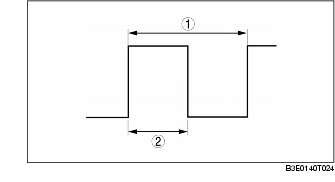|
Correction
|
Target
|
Condition
|
Correction amount
|
|
A/C load correction
|
Prevents drop in idle speed due to A/C operation.
|
A/C on
|
During A/C operation→correction
|
|
P/S load correction
|
Prevents drop in idle speed due to P/S operation
|
P/S operation
|
During P/S operation→correction
|
|
Electrical load correction
|
Prevents drop in idle speed due to electrical load operation.
|
Idle speed during electrical load operation and under any condition during driving
|
High electrical load→large correction
|
|
D-range correction
|
Prevents drop in idle speed due to shifting into D-range
|
D range signal (TR switch) input
|
If difference between idle speed and turbine speed during D-range signal input is large →large correction
|
|
Dashpot correction
|
Prevents drop in idle speed due to insufficient intake air amount during deceleration.
|
Decelerated
|
High engine speed→large correction
|
|
Correction at engine start
|
Prevents drop in idle speed after engine start.
|
Immediately after cranking and engine start
|
Low engine coolant temperature→large correction
|
|
Hot engine restart correction
|
Prevents drop in idle speed due to hot engine start.
|
Just after cranking and engine start when the engine coolant temperature is 60°C {140°F} or more
|
High intake airflow temperature→large correction
|
|
Feedback correction A
|
Sets idle speed to target engine speed.
|
Idle speed while idling (vehicle stopped) is over or under the target engine speed (except during test mode when engine speed is 300 rpm or less).
|
Actual idle speed
Target engine speed or less→volume increase correction
Target engine speed or more→volume decrease correction
|
|
Feedback correction B
|
Sets to the target engine speed when the idle speed has decreased to the range not corrected by feedback correction A, and prevents a decrease in idle speed.
|
During deceleration at fully closed throttle, the engine speed is the target engine speed or more and when the feedback correction A is not performed (Except during test mode).
|
Large difference between actual idle speed and target engine speed→large correction
|
|
Engaged coasting clutch volume increase correction
|
Reduces shock when the transaxle coasting clutch is engaged.
|
Coasting clutch engaged
|
High vehicle speed→large correction
|
|
Fuel cut recovery reduction correction
|
Lessens shock at fuel cut recovery
|
Fuel cut recovery
|
Large difference between actual idle speed and target engine speed→large correction
|
|
Learning correction
|
Stores intake air amount changes based on differences between engines and deterioration over time, and feedback.
|
During feedback correction A when engine coolant temperature is 85°C {185°F} or more and intake air temperature is 85°C {185°F} or less.
|
While idling→average value of feedback correction A
|
